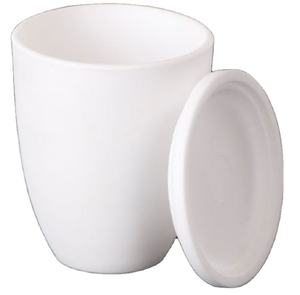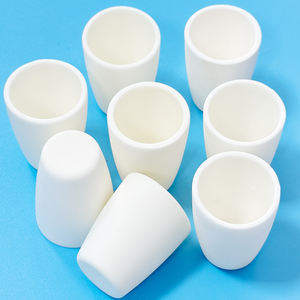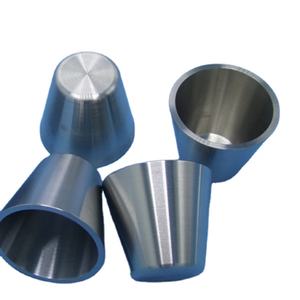Professional industry ceramic supplier, silicon nitride, silicon carbide, aluminum nitride and any other kinds of ceramics.
PRODUCT PARAMETERS
Description
Overview of High Temperature Resistant Al2O3 Alumina Ceramic Crucible
High Temperature Resistant Al2O3 Alumina Ceramic Crucible are specialized containers designed for withstanding extremely high temperatures in laboratory and industrial settings. They are essential for processes such as melting, calcining, and heat-treating a wide variety of materials, including metals, glasses, and chemicals. Our crucibles are engineered for superior thermal stability and chemical resistance, ensuring purity and reliability in the most demanding applications.
Features of High Temperature Resistant Al2O3 Alumina Ceramic Crucible
-
Exceptional Thermal Shock Resistance: Withstands rapid temperature changes without cracking, ensuring durability and a long service life.
-
High-Temperature Stability: Maintains structural integrity at extreme temperatures, often exceeding 1500°C.
-
Excellent Chemical Inertness: Resists corrosion and reaction with molten metals, acids, and aggressive chemical fluxes.
-
High Purity & Low Contamination: Manufactured from premium materials to prevent sample contamination during sensitive processes.
-
Optimized Thermal Properties: Designed for efficient heat transfer and consistent performance in furnace environments.
-
Robust Mechanical Strength: Offers good resistance to physical impact and abrasion during handling and use.
Specifications of High Temperature Resistant Al2O3 Alumina Ceramic Crucible
This alumina ceramic crucible handles extreme heat. It works reliably up to 1600°C continuously. Short bursts can reach 1750°C. This makes it perfect for demanding high-temperature tasks. The material is nearly pure Al2O3 alumina ceramic. Its purity is 99.5% or higher. This purity is key for its strength and heat tolerance. It won’t crack or warp easily under sudden temperature changes. This thermal shock resistance is crucial for lab work. It also resists chemical attacks. Acids and alkalis don’t damage it much. This keeps your samples pure and prevents contamination.
The crucible comes in many sizes. Common volumes are 5ml, 10ml, 20ml, 50ml, 100ml, and 200ml. Larger sizes are available too. The walls are thick and strong. This builds toughness and helps manage heat evenly. The surface is very smooth. This finish stops materials from sticking. It also makes cleaning simple. Its high density blocks gases and liquids. This protects your materials during heating.
You can use it for melting metals like gold, silver, copper, and platinum. It works well for sintering powders. It’s great for calcining materials. It handles ashing samples. It supports crystal growth experiments. Its stability suits advanced research. It’s also good for quality control testing. This crucible offers dependable performance where heat matters most. It replaces less durable options like porcelain or graphite.
Applications of High Temperature Resistant Al2O3 Alumina Ceramic Crucible
High temperature resistant Al2O3 alumina ceramic crucibles handle extreme heat exceptionally well. These crucibles work reliably where other materials fail. Their main strength is resisting temperatures far beyond what metal or plastic can manage. This makes them vital for many demanding tasks.
In laboratories, scientists constantly need crucibles that won’t crack or contaminate samples under intense heat. Alumina crucibles are perfect for melting metals, fusing samples, or analyzing materials. They keep experiments pure and results accurate. Chemists trust them because alumina barely reacts with most acids or alkalis. This chemical stability is crucial.
Industrial processes rely heavily on these crucibles too. They are essential for processing raw minerals or refining precious metals like gold and platinum. Factories use them to melt glass batches or sinter advanced ceramics. The crucible must survive repeated thermal shocks without breaking. Alumina ceramic handles rapid heating and cooling cycles effectively.
Metal casting foundries also benefit. Alumina crucibles melt aluminum, copper alloys, and other non-ferrous metals efficiently. They resist the corrosive effects of molten metal much better than graphite or clay alternatives. This resistance means longer service life and fewer replacements.
The material itself is very hard and strong. Alumina ceramic resists wear and abrasion over time. It doesn’t soften or deform easily under load at high temperatures. This structural integrity is key for safety and consistent performance. Users get a dependable tool that withstands tough conditions day after day.
Company Profile
Tanki New Materials Co.Ltd. focus on the research and development, production and sales of ceramic products, serving the electronics, ceramics, chemical and other industries. Since its establishment in 2015, the company has been committed to providing customers with the best products and services, and has become a leader in the industry through continuous technological innovation and strict quality management.
Our products includes but not limited to Aerogel, Aluminum Nitride, Aluminum Oxide, Boron Carbide, Boron Nitride, Ceramic Crucible, Ceramic Fiber, Quartz Product, Refractory Material, Silicon Carbide, Silicon Nitride, ect. please feel free to contact us.

Payment Methods
T/T, Western Union, Paypal, Credit Card etc.
Shipment Methods
By air, by sea, by express, as customers request.
5 FAQs of High Temperature Resistant Al2O3 Alumina Ceramic Crucible
What material makes this crucible special?
This crucible uses pure Al2O3 alumina ceramic. Alumina ceramic handles extreme heat very well. It resists chemical attacks effectively. This material keeps its strength even when red hot. It won’t melt or warp easily under normal lab furnace conditions. Crucibles made from alumina are reliable for tough jobs.
How hot can I safely use this crucible?
You can use this crucible continuously up to 1700°C (3092°F). Short bursts near 1800°C (3272°F) are sometimes acceptable. Check the specific product sheet first. Never exceed the maximum temperature rating. Going too hot risks cracking the crucible fast. Always respect the temperature limit.
Will sudden temperature changes break it?
Alumina ceramic resists thermal shock better than many materials. It still needs careful handling. Avoid plunging a hot crucible directly into cold water. Let it cool down slowly inside the furnace. Prevent rapid heating or cooling cycles whenever possible. Gradual temperature changes are much safer.
How do I clean it after use?
Remove cooled residues physically first. Use a non-metallic scraper gently. Chemical cleaning often works well. Try soaking in hot, concentrated acids like sulfuric or nitric acid. Avoid hydrofluoric acid completely; it damages alumina. Rinse thoroughly with pure water after cleaning. Ensure it’s completely dry before the next heating cycle.
How long will one crucible last?
Crucible lifespan varies greatly. It depends entirely on your specific use. Factors include maximum temperature reached, heating/cooling speed, chemical exposure, and mechanical handling. Using it within its limits consistently extends its life. Inspect the crucible carefully before each use. Look for cracks, chips, or severe surface wear. Replace it immediately if you see damage.
REQUEST A QUOTE
RELATED PRODUCTS

Laboratory High Purity Crucible Pyrolytic Boron Nitride PBN Boat Ceramic Crucibles Boat

95% Alumina Ceramic Crucible Alumina Thermal Analysis Small Crucible with Lid

High-temperature Resistant Alumina Ceramic Crucible

Custom High Purity 30ml Metal Melting Materials Sintering 99% Alumina Ceramic Crucible With Lid

High Temperature Resistant Cordierite Mullite Sagger Alumina Ceramic Crucible for Glass Melting



